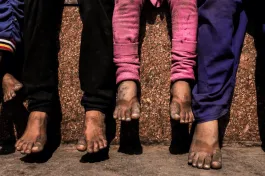Listen to the podcast by Radhicka Kapoor here.
The widespread loss of jobs and incomes following the dual shocks of the pandemic and the lockdown have generated much concern. What is particularly worrying is that the impact of these shocks is not likely to have been uniform across the workforce.
Using data from the latest Periodic Labour Force Survey (PLFS 2018-19), which captures the conditions of the labour market prior to the Covid-19 crisis, I argue here that the effects of the shocks would be particularly harsh on specific groups of workers. These would be the less-educated workers who are typically engaged in low paying, precarious and unstable work arrangements in sectors that have been hardest hit by the shocks. Therefore, we can expect the crisis to accentuate the pre-existing inequalities in India’s dualistic labour market, which has been characterized by stark disparities between, at one end, a small percentage of the workforce that is engaged in jobs that offer stability of income and social security benefits, and, at the other end, a disproportionately large proportion engaged in informal employment.
In 2018–19, the most recent year for which for the labour force data is available, 52% of the workforce were classified as self-employed. Over 95% of the self-employed were either own account workers (i.e., those who operate enterprises without hired labour) or unpaid family workers. Less than 5% of the self-employed were classified as employers (i.e., those who operated enterprises with hired labour). Approximately 24% of the workforce were employed as casual workers with no stability of income or security of tenure. And like the self-employed, they too were outside the ambit of employer-employee relationships that offered employment-linked benefits.
Regular wage salaried (RWS) workers constituted the remaining 24% of the workforce. These workers received a salary on a regular basis and not on the basis of daily or periodic renewal of a work contract. This made them better off than casual workers, but not all of them had access to social security benefits or secure job contracts.
[A] mere 4.2% of the total workforce [in 2018-19] had jobs that offered them the maximum possible protection that would … fit the criteria of what is often described as a ‘good job’ or ‘decent work’.
In 2018–19, the proportion of RWS workers who had access to at least one social security benefit (among provident fund/pension, gratuity, health care, or maternity benefits) and therefore a minimal degree of social protection was 40.6%. These workers — referred to as regular formal workers — accounted for 9.6% of the total workforce. Of course, it should be noted that the definition of regular formal employment based on having access to just one social security benefit is a fairly relaxed one. If we adopt more stringent then only 17.7% of RWS workers had access to all available forms of social security cover. This, in turn, means that a mere 4.2% of the total workforce had jobs that offered them the maximum possible protection that would therefore fit the criteria of what is often described as a ‘good job’ or ‘decent work’.
Regular formal jobs provide some degree of security, they also, on average, offer higher earnings than regular informal jobs (i.e., the RWS jobs that offer no social security benefits), casual work, or self-employment. This is apparent from Table 1 that reports average earnings by employment status. Casual workers, who on average earn Rs 209 a day, are clearly at the bottom of the pyramid. The financial vulnerability of casual workers is exacerbated by the fact that they are unlikely to get work every day and are therefore not likely to earn the bare minimum needed for the month. A sudden loss of income for those who have such low levels of earnings is likely to be devastating and will push them deeper into poverty. This may well be true of the self-employed as well, where 58% reported monthly earnings below Rs 9,750 (the amount recommended in January 2019 as a national minimum wage by a Government of India-constituted expert committee). 1 The expert committee set the national minimum wage (NMW) for India at Rs 375 per day (or Rs 9,750 per month) as of July 2018, irrespective of sectors, skills, occupations, or rural-urban locations. It also introduced an additional house rent allowance (city compensatory allowance), averaging up to Rs 55 per day (Rs 1,430 per month) for urban workers over and above the NMW. It also established the NMW for five different regions with diverse socio-economic and labour market situations, ranging from a low of Rs 342 per day (Rs 8,892 per month) in Region I to a high of Rs 447 per day (Rs 11,622 per month) in Region IV. In fact, 42% of RWS workers too earned less than this amount.

On the basis of earnings and access to social security, the four basic forms of employment described above fall into a hierarchical order: regular formal employment, regular informal employment, self-employment, and casual employment (Ghose 2019). That just a small proportion of workers is engaged in what is described as the best form of employment (and that too based on a very relaxed definition of formal employment) is reflective of the overall conditions of the quality of employment.
In previous employment-unemployment surveys too, the share of regular formal workers was barely above 10%. Regular formal jobs are a privilege for a limited few and are also typically held by those at the top of the education ladder. In 2018–19, more than 50% of those in regular formal jobs were graduates or post-graduates (Table 2). In contrast, most self-employed and casual workers had low levels of education. For instance, 25.7% of the self-employed were not literate and 80% had secondary education or below. Amongst casual workers, the share of those who were not literate was 37% and those who had secondary education or below was over 90%. That it is the relatively less educated who are predominantly engaged in precarious work arrangements and therefore have a high probability of being rendered unemployed suggests that they stand to bear a disproportionate brunt of the Covid-19 shock.

Furthermore, the less educated are typically employed in sectors where the first order effects of the pandemic have been severe and the options for remote work are either limited or do not exist. Outside of the agricultural sector, which accounts for 42.2% of total employment, the three sectors which cumulatively account for approximately 36% of total employment are manufacturing, construction and trade, and hotels and restaurants. These sectors have been significantly affected by the pandemic and the lockdown and other containment policies, due to both supply-side disruptions and a fall or collapse of demand. Adoption of physical distancing measures has not only adversely impacted production but has also affected consumption patterns of the goods and services being provided by these industries. These sectors are a critical source of employment for the less educated (Table 2).
For instance, over 90% of workers in construction have secondary education or below. In the manufacturing sector and the trade, hotels and restaurants sector the corresponding statistics stood at 76% and 70%, respectively. What is more, as the statistics in Table 4 suggest, these sectors are also dominated by informal and precarious work arrangements. This makes workers engaged in these sectors highly vulnerable to layoffs. In the construction sector over 80% of the workers are in casual employment and therefore can be fired easily. In the manufacturing sector, too, almost 85% are in informal work arrangements. In the trade, hotels and restaurant segment, less than 5% are in regular formal jobs.

In contrast, high-end services sectors (such as finance, business, real estate and public administration, health, and education) are more amenable to remote work and have a higher share of regular formal employment. As Table 4 shows, the share of casual workers in these sectors is less than 5%. These sectors offer more secure terms of employment and they also pay higher wages. This gives workers a greater financial wherewithal to cope with any loss of earnings or periods of unemployment. However, the contribution of these sectors to total employment is low (approximately 14%). Furthermore, these sectors largely generate employment opportunities for those at the top end of the education ladder (Table 3).

That the impact of the Covid-19 crisis on workers varies and depends on the nature of the employment arrangement and the sector of employment, suggests that we are likely to see increasing inequality in India’s labour markets. There are the more educated workers who are engaged in work arrangements that offer a steady source of income and some degree of social security and who are able to shift their work online. Then there are those who have low levels of education and are engaged in precarious and low paying work of the kind that does not offer them the luxury of working from home. It would not be unreasonable to expect the latter to account for a disproportionate share of the pandemic-related job losses.
Estimates from CMIE peg job losses at 122 million in April 2020, with most of these losses accounted for by small traders, hawkers and daily wage-earning labourers (90 million) who fall in the category of casual workers and self-employed. Given the low and volatile earnings of this cohort, they are at a risk of falling into poverty. Their financial inability to cope with the ongoing economic distress is evident from several recent surveys.
Even at the best of times, the poor and uneducated do not have the financial wherewithal to remain unemployed in developing countries such as India where there is no unemployment insurance.
For instance, a survey conducted by economists from Azim Premji University after the announcement of the lockdown in March found that the share of households without enough money to buy even a week's worth of essentials stood at 64% in urban areas and 35% in rural areas (Lahoti et al. 2020). In a separate study, Bertrand, Krishnan and Schofield (2020) analysed data collected by CMIE and found that only 66% of households reported having the resources to go on for more than another week before facing distress. The ILO (2020) estimates that in India about 400 million workers in the informal economy are at risk of falling deeper into poverty.
Estimates from the World Bank suggest that the Covid-19 shock will push 12 million people in India into extreme poverty i.e. those living on less than $1.90 per day (Mahler et al. 2020). Significantly, these estimates are based on the poverty data available from the Consumer Expenditure Survey (CES) of 2011–12). More recent data from the CES (2017-18), leaked to and published by the Business Standard (Jha 2019), indicates that there was a decline in real consumption expenditure of around 4% per annum between 2011–12 and 2017–18, and that poverty in India may have started rising even before the Covid-19 crisis. This suggests that the estimate of those at risk of falling into extreme poverty based on the CES of 2011-12 may well be on the lower side.
Even at the best of times, the poor and uneducated do not have the financial wherewithal to remain unemployed in developing countries such as India where there is no unemployment insurance. This is reflected in their low unemployment rates. In 2018–19, the unemployment rate of the illiterate was 1.08%, whilst the rate for those with secondary education and above was 11.03%.
In the current crisis, where there is considerable uncertainty about the duration and intensity of the pandemic and an absence of direct income support, the poor and illiterate certainly do not have the luxury of waiting for a good job. In rural areas, MGNREGA has emerged as a critical safety net. It involves hard physical labour and is likely to have provided employment for the unskilled and low skilled. In June 2020, 32.2 million households were employed under the programme, a 50% increase from the number of households employed in June 2019. However, in urban areas where there is no fallback employment option such as MGNREGA and the costs of living are higher than in rural areas, many of those rendered unemployed will be compelled to do any low paying and low productivity work that comes their way in order to eke out a subsistence living. They are likely to create self-employment or seek casual employment, even if the remuneration offered is lowered or the terms of employment are more precarious than before the shock of the pandemic.
Against this backdrop, it is perhaps not surprising that we are already witnessing a decline in the unemployment rate from the estimate of 23% reported for April and May. For June, the CMIE estimates the unemployment rate at 10.99%. In rural and urban areas, the rate stood at 10.52% and 12.02%, respectively. The lower unemployment rate in rural areas is not just a consequence of employment generated under MGNREGA, but also of the uptick in agricultural activities during the kharif sowing season. The overall decline in the unemployment rate may give the illusion that the effects of the pandemic and lockdown on the labour market are not long lasting and persistent. However, it is important to note that the decline in open unemployment rate masks the problem of underemployment. This problem is not just of reduced working hours but also of a deterioration in the quality of employment in terms of earnings, job security and access to social security, in particular in urban areas.
Addressing the deteriorating conditions of employment and the widening disparities in the job market requires a strengthening and rebuilding of the labour market from the bottom up.
Recent evidence suggests that by adversely affecting the prospects for market work, pandemics have driven more activity into precarious work. Furceri et al. (2020) find that there is a statistically significant increase in the share of self-employment for about three years following an epidemic. Whether laid off regular formal workers, particularly the more educated ones, too opted for self-employment or other informal work arrangements is unclear at this point. They may have even chosen to withdraw from the labour force for the short term, given the bleak prospects of finding new regular formal work in the midst of the pandemic and the contraction of the economy. Whilst a detailed analysis of the issue will be possible only once data on the labour force participation and employment rates are available, the recent decline in the unemployment rate is potentially a consequence of two factors. One, the fact that the poor and uneducated do not have the luxury of remaining unemployed. Two, the educated and better off, who typically have a high unemployment rate, may have withdrawn from the labour force. Of course, the former is likely to be the more dominant factor in a developing country.
Therefore, despite the recent decline in unemployment rates estimated by the CMIE, the employment situation remains dismal. Prior to the Covid-19 crisis, much of the workforce was already engaged in unstable work arrangements that offered no social security benefits and provided low earnings, which left them with little or no financial buffer to protect themselves from any shock. The pandemic and lockdown have worsened the situation by pushing even more people into a dire position.
Addressing the deteriorating conditions of employment and the widening disparities in the job market requires a strengthening and rebuilding of the labour market from the bottom up. In the immediate term, this calls for an expansion of social assistance and public workfare programmes to provide relief and protection to the most vulnerable and disadvantaged. However, this alone is not enough. In the long run, there is a need to expand earnings, job opportunities and give security to those at the lower end of the education and skills ladder. This will require a serious rethinking of our growth and development strategy.
I am extremely grateful to Prof Ajit Ghose, Dr Nomaan Majid and Srinivasan Iyer for their valuable comments and suggestions. I would like to express my sincere thanks to Abhishek Kumar for his help with the Periodic Labour Force Survey data.









